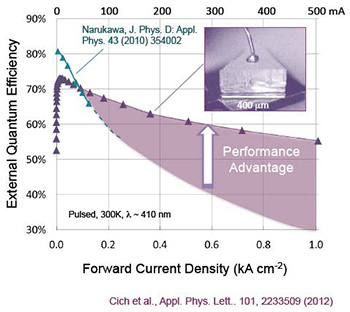Soraa Inc of Fremont, CA, USA, which develops solid-state lighting technology built on ‘GaN on GaN’ (gallium nitride on gallium nitride) substrates, has announced the next generation of its high external quantum efficiency GaN-on-GaN LEDs. As described in Appl. Phys. Lett. 101, 223509 (2012), the firm’s new LED outperforms the best-documented LED laboratory result by Nichia Chemical Co at current densities of 100A/cm2 and beyond (J. Phys. D: Appl. Phys. 43, 354002).
The record performance is a testament to the vision of company founder and GaN-on-GaN pioneer professor Shuji Nakamura, says chief technology officer Mike Krames. “We have just scratched the surface in terms of performance gains from our GaN-on-GaN LED technology,” he reckons.

Graphic: Soraa’s record-performance GaN-on-GaN LED.
Soraa reckons that its GaN-on-GaN LEDs handle significantly more current and emit ten times more light per unit area of LED wafer material than conventional LEDs made by depositing GaN layers on cheaper foreign substrates like sapphire, silicon carbide (SiC) or silicon. Its GaN-on-GaN technology leverages the advantages of the native substrate, including over 1000 times lower crystal defect densities that allow reliable operation at very high current densities (the same principle that enabled Blu-ray laser diodes). In addition to superior crystal quality, the native substrate’s optical transparency and high electrical and thermal conductivities enable a very robust, simple LED design that delivers maximum performance, the firm claims. Another advantage of GaN-on-GaN is that it enables considerable flexibility in the choice of crystal growth plane.
“We’ve developed a comprehensive intellectual property program and patent portfolio covering the technology,” says Krames.
Soraa leveraged the advantages of its first-generation GaN-on-GaN LEDs by introducing in 2012 what was claimed to be the first true full-visible-spectrum LED MR16 lamps — a superior alternative to 50-Watt halogen MR16 lamps. The firm’s LED MR16 lamps have a color rendering index (CRI) of 95 and R9 of 95 (higher than most halogen lamps) and, compared with halogen lamps, produce no ultraviolet (UV) or infrared (IR); last up to 10 times as long; use 75% less energy; run cooler; produce a much more consistent and efficient beam; and are compatible with existing lamp fixtures and lighting infrastructure.





